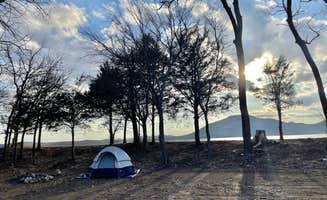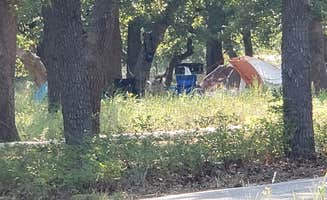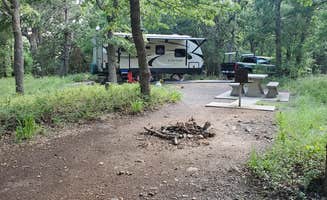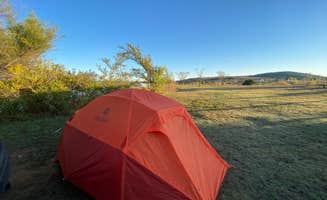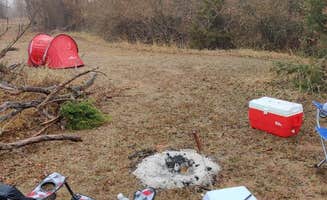Camping near Meers, Oklahoma centers around the Wichita Mountains, which rise to 1,400 feet above the surrounding plains. The region features granite outcroppings, oak forests, and mixed-grass prairies with summer temperatures commonly reaching the mid-90s. Campgrounds in the area provide access to several lakes and wildlife viewing opportunities, with specific regulations regarding water usage due to past contamination issues.
What to do
Hiking opportunities: Wichita Mountains Wildlife Refuge offers numerous trails accessible directly from Doris Campground. "Hiking trails can be accessed directly from Doris Campground, or there are numerous other trails in other areas a short drive away," notes Brad N. The refuge includes terrain ranging from prairie to mountain trails with varying difficulty levels.
Water activities: Tom Steed Reservoir at Great Plains State Park Campground provides boating, fishing and swimming options. "Boating, kayaking, swimming, camping, hiking. We always enjoy our visits to this park. Facilities and grounds are well kept," reports Kelly B. The park features boat ramps and designated swimming areas.
Wildlife viewing: Multiple campgrounds offer wildlife sightings, particularly buffalo and longhorn cattle. "There is free roaming Buffalo and Longhorn Cattle so don't be surprised if you see one in the Campground," advises William A. Prairie dog towns, elk, and deer are commonly spotted throughout the region, particularly in early morning or evening hours.
What campers like
Lake views: Many sites at Lake Lawtonka East Campground offer direct water access with mountain panoramas. "We found a spot we liked and drove across the highway to the Lake office and left our $10 fee in the drop box. Very quiet, beautiful lake view," writes Dusty B. Sites along the eastern shore provide particularly good views of Mount Scott.
Military history: Fort Sill offers museums and historical sites near camping areas. "Join 'Friends of the Wichitas' for exclusive tours of the private areas of the park and access to stargazing and wildlife events. Drive up Mount Scott for beautiful views of neighboring Lake Lawtonka, and wonderful sunsets," suggests Dusty G. The area contains significant Native American and military historical sites.
Secluded tent sites: Several campgrounds offer tent-only areas away from RV sections. "East Side – Lake Lawtonka primitive tent camping sites are very well scattered and away from each other. They have two separate areas for primitive camping along with an RV and camper area," explains Justin F. These sites typically cost $8-10 per night with varying levels of amenities.
What you should know
Water safety concerns: Potable water availability varies significantly between campgrounds. "Please note that at the time of this review (3/2020) there is NO potable water anywhere in the WMWR. An e.coli contamination in 2017 is still not resolved and any an all water is considered unsafe, including all streams and lakes. Bring in your own water, the closest store is at least 30 mins away," warns Rebecca A. at Camp Doris.
Military training impacts: Artillery training at Fort Sill affects nearby campgrounds. "Artillery range practice, though sporadic, takes place at any hour of any day. If you treat it like an unexpected fireworks display you'll actually look forward to it," suggests Dave V. Artillery noise can occur at all hours and may be particularly startling for first-time visitors.
Cell service limitations: Most campgrounds have minimal connectivity. "No service whatsoever Verizon or T-Mobile.. do not recommend if you have remote workdays!" reports Kiley S. Some visitors report getting limited service at visitor centers or at higher elevations, but connections remain unreliable throughout the region.
Tips for camping with families
Beach access: Lake Elmer Thomas Recreation Area offers supervised swimming. "A nice beach and cordoned swim area, complete with restrooms and shower house(11a-7p)…lifeguards," notes Dave V. The recreation area includes watercraft rentals and mini-golf for additional family activities.
Wildlife education: The visitor center provides educational programming. "The visitor center deserves at least an hour of time. Fabulous," recommends Roger W. Ranger-led programs occur seasonally and focus on local wildlife, geology, and cultural history.
Activity variety: Multiple recreational options exist within short distances. "The hiking was splendid and much better than expected. Check out the hundreds of free roaming LongHorn's, Bison and prairie dog towns," suggests Dave V. Families can combine camping with wildlife viewing, hiking, and water activities within the same trip.
Tips from RVers
Site selection: Avoid inner loop sites at Doris Campground for better views and privacy. "I don't particularly like the sites on the inside of the loops. Water view sites are circled on the map. I would be happy with these. Best sites in Loop A: 1, 2, 5, 10, 11, 13, 15. E63 is the only site I liked in the electric loop," advises Roger W. The most desirable sites fill quickly on weekends and holidays.
Hookup details: Verify electrical service compatibility before arrival. "All rv sites are 50 amp, so bring an adapter for your 30amp rig," notes Ashley H. about Lake Lawtonka East Campground. Most campgrounds offer water and electric hookups, but full-service sites are limited.
Wind protection: The open plains create significant wind exposure. "When we visited, the wind was very strong. I've been to the Wichita Mountains a ton and I know the wind can pick up quite a bit there, but without the shelter of the rocks/mountains, the wind can go wild here. If you get a campsite by the lake, make sure you're anchored in or by trees!" advises Dusty G. RVs should use proper stabilization and secure all outdoor equipment.


